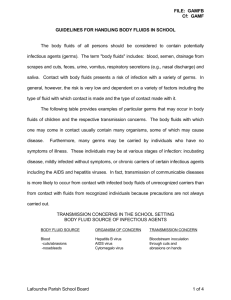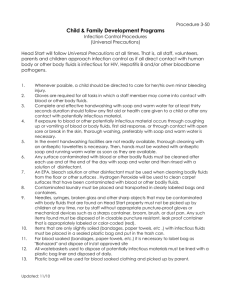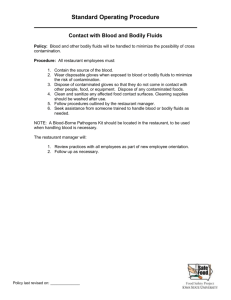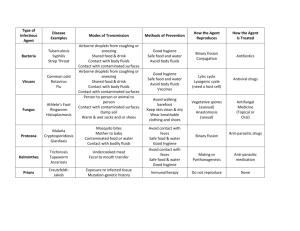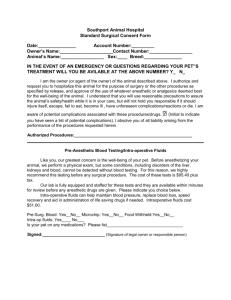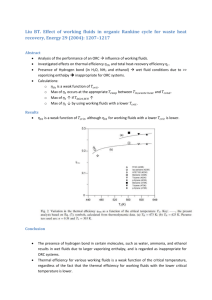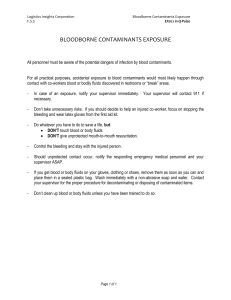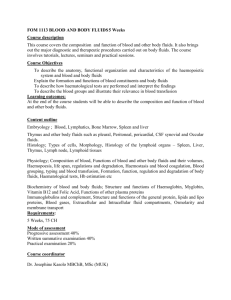EBBC-P
advertisement
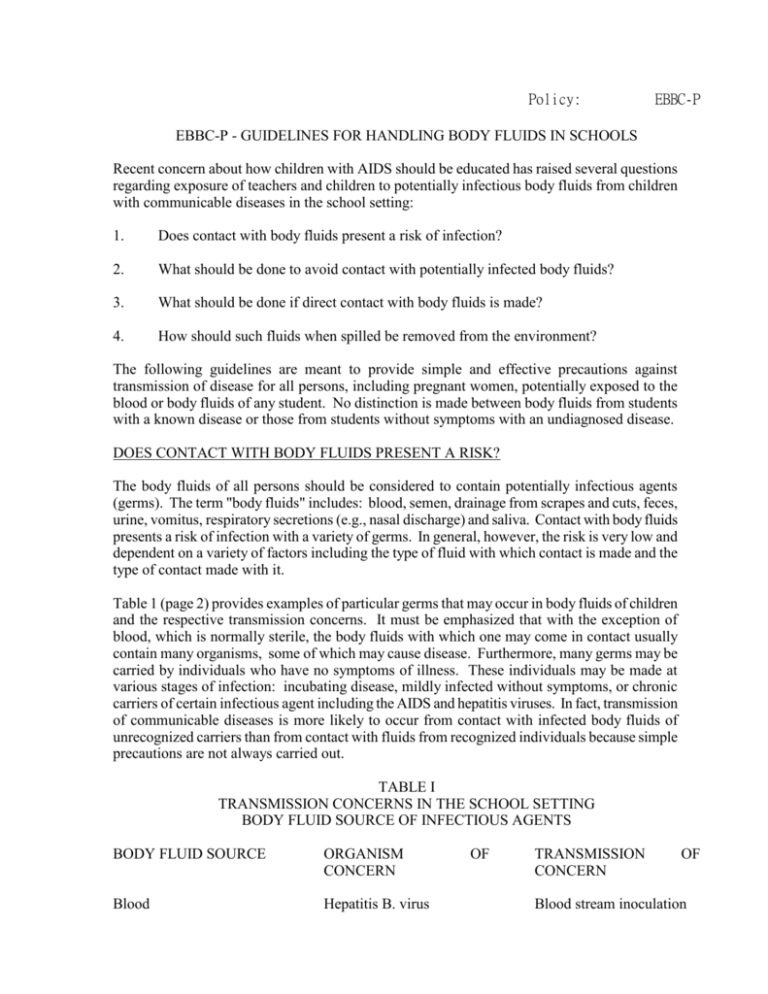
Policy: EBBC-P EBBC-P - GUIDELINES FOR HANDLING BODY FLUIDS IN SCHOOLS Recent concern about how children with AIDS should be educated has raised several questions regarding exposure of teachers and children to potentially infectious body fluids from children with communicable diseases in the school setting: 1. Does contact with body fluids present a risk of infection? 2. What should be done to avoid contact with potentially infected body fluids? 3. What should be done if direct contact with body fluids is made? 4. How should such fluids when spilled be removed from the environment? The following guidelines are meant to provide simple and effective precautions against transmission of disease for all persons, including pregnant women, potentially exposed to the blood or body fluids of any student. No distinction is made between body fluids from students with a known disease or those from students without symptoms with an undiagnosed disease. DOES CONTACT WITH BODY FLUIDS PRESENT A RISK? The body fluids of all persons should be considered to contain potentially infectious agents (germs). The term "body fluids" includes: blood, semen, drainage from scrapes and cuts, feces, urine, vomitus, respiratory secretions (e.g., nasal discharge) and saliva. Contact with body fluids presents a risk of infection with a variety of germs. In general, however, the risk is very low and dependent on a variety of factors including the type of fluid with which contact is made and the type of contact made with it. Table 1 (page 2) provides examples of particular germs that may occur in body fluids of children and the respective transmission concerns. It must be emphasized that with the exception of blood, which is normally sterile, the body fluids with which one may come in contact usually contain many organisms, some of which may cause disease. Furthermore, many germs may be carried by individuals who have no symptoms of illness. These individuals may be made at various stages of infection: incubating disease, mildly infected without symptoms, or chronic carriers of certain infectious agent including the AIDS and hepatitis viruses. In fact, transmission of communicable diseases is more likely to occur from contact with infected body fluids of unrecognized carriers than from contact with fluids from recognized individuals because simple precautions are not always carried out. TABLE I TRANSMISSION CONCERNS IN THE SCHOOL SETTING BODY FLUID SOURCE OF INFECTIOUS AGENTS BODY FLUID SOURCE ORGANISM CONCERN Blood Hepatitis B. virus OF TRANSMISSION CONCERN OF Blood stream inoculation Policy: -cuts/abrasions -nosebleeds -menses -contaminated needle AIDS virus Cytomegalovirus EBBC-P through cuts and abrasions on hands Direct blood inoculation stream *Feces -incontinence Salmonella bacteria Shigella bacteria Rotavirus Hepatitis A virus Oral inoculation contaminated hands from *Urine -incontinence Cytomegalovirus Bloodstream and oral (?) inoculation from contaminated hands Respiratory Secretions -saliva -nasal discharge Oral inoculation from contaminated hands Mononucleosis virus Common cold virus Influenza virus AIDS virus Hepatitis B virus Bloodstream inoculation through cuts and abrasions on hands; bites *Vomitus Gastrointestinal viruses, e.g., (Norwalk agent Rotavirus) Oral inoculation contaminated hands Semen Hepatitis B AIDS virus Gonorrhea Sexual contact (intercourse) from *Possible transmission of AIDS and Hepatitis B is of little concern from these sources. There is no evidence at this time to suggest that the AIDS virus is present in these fluids. WHAT SHOULD BE DONE TO AVOID CONTACT WITH BODY FLUIDS? When possible, direct skin contact with body fluids should be avoided. Disposable gloves should be available in at least the office of the custodian, nurse, or superintendent. Gloves are recommended when direct hand contact with body fluids is anticipated (e.g., treating bloody noses, handling clothes soiled by incontinence, cleaning small spills by hand). If extensive contact is made with body fluids, hands should be washed afterwards. Gloves used for this purpose should be put in a plastic bag or lined trash can, secured, and disposed of daily. WHAT SHOULD BE DONE IF DIRECT SKIN CONTACT OCCURS? Policy: EBBC-P In many instances, unanticipated skin contact with body fluids may occur in situations where glove may be immediately unavailable (e.g., when wiping a runny nose, applying pressure to a bleeding injury outside the classroom, helping a child in the bathroom). In these instances, hands and other affected skin areas of all exposed persons should be routinely washed with soap and water after direct contact has ceased. Clothing and other non-disposable items (e.,g. towels used to wipe up body fluid) that are soaked through with body fluids should be rinsed and placed in plastic bags. If pre-soaking is required to remove stains, (e.g. blood, feces), use gloves to rinse or soak the item in cold water prior to bagging. Clothing should be sent home for washing with appropriate directions to parents/teachers (see page 5). Contaminated disposable items (e.g., tissues, paper towels, diapers) should be handled as with disposable gloves. HOW SHOULD SPILLED BODY FLUIDS BE REMOVED FROM THE ENVIRONMENT? Most schools have standard procedures already in place for removing body fluids (e.g., vomitus). These procedures should be reviewed to determine whether appropriate cleaning and disinfection steps have been included. Many schools stock sanitary absorbent agents specifically intended for cleaning body fluid spills (e.g., ZGOOP, Parsen Mfg. Co., Philadelphia, PA). Disposable gloves should be worn when using these agents. The dry material is applied to the area, left for a few minute to absorb the fluid, and then vacuumed or swept up. The vacuum bag or sweepings should be disposed of in a plastic gab. Broom and dustpan should be rinsed in a disinfectant. No special handling is required for vacuuming equipment. HAND WASHING PROCEDURES Proper hand washing requires the use of soap and water and vigorous washing under a stream of running water for approximately 10 seconds. Soap suspends easily removable soil and microorganisms allowing them to be washed off. Running water is necessary to carry away dirt and debris. Rinse under running water. Use paper towels to thoroughly dry hands. DISINFECTANTS An intermediate level disinfectant should be used to clean surfaces contaminated with body fluids. Such disinfectants will kill vegetative bacteria, fungi, tubercle bacillus and viruses. The disinfectant should be registered by the U. S. Environmental Protection Agency (EPA) for use as a disinfectant in medical facilities and hospitals. Various classes of disinfectants are listed below. Hypochlorite solution (bleach) is preferred for objects that may be put in the mouth. 1. 2. Ethyl or isopropyl alcohol (70%) Phenolic germicidal detergent in a 1% aqueous solution (e.g. Lysol*). 3. Sodium Hypochlorite with at least 100 ppm available chlorine (1/2 cup household bleach in 1 gallon water, needs to be freshly prepared each time it is used). 4. Quaternary ammonium germicidal detergent in 2% aqueous solution (e.g., Tri-quat*, Mytar* or Sage*). 5. Iodophor germicidal detergent with 500 ppm available iodine (e.g., Wescodyne*). Policy: EBBC-P DISINFECTION OF HARD SURFACES AND OF EQUIPMENT After removing the soil, a disinfectant is applied. Mops should be soaked in the disinfectant after use and rinsed thoroughly or washing in a hot water cycle before rinse. Disposable cleaning equipment and water should be placed in a toilet or plastic gab as appropriate. Non-disposable cleaning equipment (dust pans, buckets) should be thoroughly rinsed in the disinfectant. The disinfectant solution should be promptly disposed down a drain pipe. Remove gloves and discard in appropriate receptacles. DISINFECTION OF RUGS Apply sanitary absorbent agent, let dry and vacuum. If necessary, mechanically remove with dust pan and broom, then apply rug shampoo (a germicidal detergent) with a brush and revacuum. Rinse dust pan and broom in disinfectant. If necessary, wash brush with soap and water. Dispose of non-reusable cleaning equipment as noted above. *Brand names used only for examples of each type of germicidal solution and should not be considered an endorsement of a specific product. LAUNDRY INSTRUCTIONS FOR CLOTHING SOILED WITH BODY FLUIDS The most important factor in laundering clothing contaminated in the school setting is elimination of potentially infectious agents by soap and water. Addition of bleach will further reduce the number of potentially infectious agents. Clothing soaked with body fluids should be washed separately from other items. Pre-soaking may be required for heavily soiled clothing . Otherwise, wash and dry as usual. If the material is not colorfast, add ½ cup non-Clorox bleach (3.g., Clorox II, Borateem) to the wash cycle. GUIDELINES FOR HANDLING BODY FLUIDS IN SCHOOLS was prepared by Elaine Brainerd, M.A., R.N., State Department of Education, in consultation with James Hadler, M. D. MPH Chief, Epidemiology Section, Patricial Checko, MPH, Epidemiology Program, and William Sabella, AIDS Coordinator, Connecticut State Department of Health Services. December 1985. Adopted: 1-21-88
